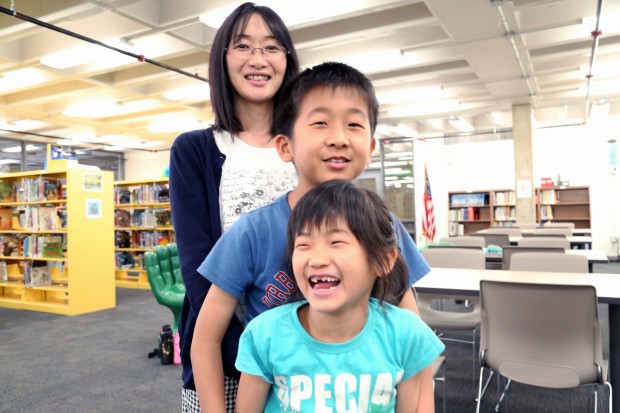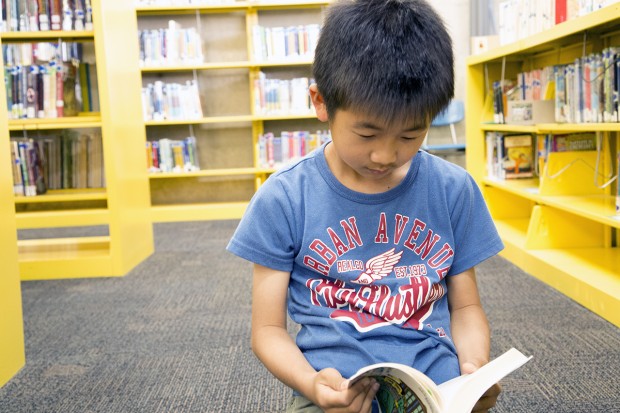As More Japanese Move To Columbus The Schools Seek To Adapt

Hiroko Murabayashi moved to Columbus, Ind. from Japan in August with her husband and two kids. They came for her husband’s job at Enkei, a Japanese wheel company with a branch in Columbus. Her children, Yoki, 9, and Rico, 7, attend Southside Elementary school in the Bartholomew County School Corporation and receive English language services. When they started the year they didn’t speak any English. (Claire McInerny/Indiana Public Broadcasting)
COLUMBUS, Ind. — Over the last five years, the number of English learners in Indiana grew faster than the national average. Today, five percent of all students in the state don’t speak English as their first language.
This growing population comes to Indiana from all over the world. The new Hoosiers bring more than 200 languages into schools. International companies in Columbus are attracting families from a handful of different countries, including Japan, India and China.
And while the majority of the district’s English Learners are native Spanish speakers, traditionally the largest population of EL students in Columbus, the second biggest group is Japanese students.
- As More Japanese Families Move to Columbus, The School District Forces Itself To AdaptListen to the radio version of this story here.Download
“There have been more Japanese students every year,” says English Learner teacher Tony Butiste. He says the number of Japanese students he teaches increased the most over the last three years. The district now teaches 84 Japanese-speaking students.
And with a growing number of students from one country, the school district is realizing they must adapt to help educate these students properly.
From Japan To Indiana, With A Few Road Bumps
Nine-year-old Yoki Murabayashi and his seven-year-old sister Rico, are almost done with their first school year at Southside Elementary School, and it’s been a school year full of change.
Yoki and Rico moved to Columbus in August, after their dad was transferred to the Columbus branch of Enkei, a Japanese wheel company.
Hiroko Murabayashi, Yoki and Rico’s mother, was very nervous when she enrolled them in school.

Nine-year-old Yoki Murabayashi reads a book in Japanese, his native language. (Claire McInerny/Indiana Public Broadcasting)
“They didn’t know anything, even the alphabet,” Hiroko says through a volunteer translator.
At first, that adjustment was tough for the whole family, including seven-year-old Rico.
“In the beginning she cried,” says Hiroko. “She didn’t want to go to school and every morning she cried.”
Hiroko recalls one time when her husband was out of town for work, she got sick and couldn’t get out of bed. Eventually there wasn’t any food in the house.
“In Japan kids can go to the stores, by themselves, even when they’re that young,” she says. “But here we can’t.”
So rather than sending the kids down to the store, they had to wait for a friend to find out Hiroko was sick and bring the family dinner.
But besides adjusting to the cultural differences between Japan and Indiana, the biggest challenge for the family has been learning English.
“We need to meet them halfway.”
In Tony Butiste’s third grade group of English learners, there are 15 students who speak six different languages. Besides Japanese, students speak Spanish, Portuguese, Hebrew, Marait and Temil.
“Oh and of course last but not least, what’s the target?” Butiste calls out to his class. “What are we trying to learn?”
“English!” They all respond.
Southside Elementary, the school the Murayabashi’s go to, has the biggest population of Japanese students in the district. But for Butiste, the school’s one certified English language teacher, there are more than just Japanese speaking students he teaches.
And with kids coming from so many different backgrounds, he can only do so much to give EL students individual attention.
“We’re trying to find that balance of where we can do the most good and see the most kids,” Butiste says.
This is something that worried Hiroko when the kids first started going to school. She says she expected more one-on-one attention for the kids.
Denise Recarte runs the English learning program in the district and says as the population of Japanese kids grows, the district realizes they need to figure out how to make these families feel more comfortable in the schools.
“I just want to meet families halfway,” Recarte says. “We need to make the effort as far as a language to reach out to them and show that we’re attentive to their language.”
This is something the district already does for their Spanish speaking families.
“For our Hispanic population, we have several employees that are just dedicated to interpreting for parent conferences and translating documents,” Recarte says.
But nothing like that exists for Japanese families, and Recarte says they hope to change this. She wants to put a Japanese speaking person in the front office at Southside, but building it into the budget could be tricky, since resources allocated for English learners are never enough.
“We need to make sure all of our students are being served by a certified English language teacher,” Recarte says. “We need to make sure all of our schools who need that interpreter and that parent engagement person, that they have that. And we’re not quite there yet.”